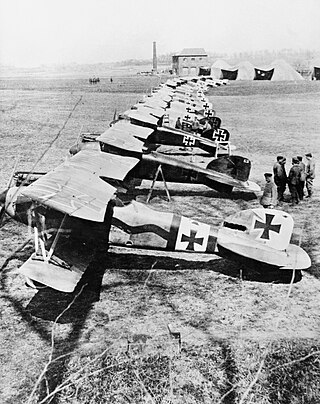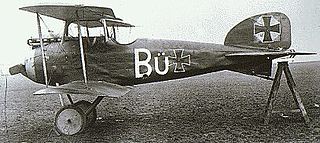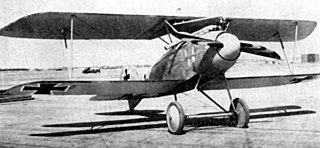
The Fokker Dr.I, often known simply as the Fokker Triplane, was a World War I fighter aircraft built by Fokker-Flugzeugwerke. The Dr.I saw widespread service in the spring of 1918. It became famous as the aircraft in which Manfred von Richthofen gained his last 17 victories, and in which he was killed on 21 April 1918.

Royal Prussian Jagdstaffel 11 was founded on 28 September 1916 from elements of 4 Armee's “Kampfeinsitzer” or KEKs) 1, 2 and 3 and mobilized on 11 October as part of the German Air Service's expansion program, forming permanent specialised fighter squadrons, or "Jastas". It became the most successful fighter squadron in the Luftstreitkräfte.

Jasta 2 was one of the best-known German Luftstreitkräfte Squadrons in World War I. Its first commanding officer was the great aerial tactician Oswald Boelcke, and it was the incubator of several notable aviation careers.

Adolf Ritter von Tutschek (16 May 1891 – 15 March 1918) PlM, MOMJ was a professional soldier turned aviator. As German air strategy turned towards concentrated air power, he was entrusted with one of the world's first fighter wings.

Ulrich Neckel Pour le Mérite, Iron Cross First and Second Class, was a World War I fighter ace credited with 30 victories.
Leutnant Olivier Freiherr von Beaulieu-Marconnay was a German World War I ace fighter pilot credited with 25 victories. Having joined the military at age 16, his success in shooting down 13 enemy aircraft led to his being appointed to command a fighter squadron, Jagdstaffel 19, at age 19. He was credited with another dozen victories before being mortally wounded. Because Germany's highest award for valor could not be granted posthumously, it was hurriedly approved just hours before his death. He is notable for being World War I's youngest recipient of the Pour le Merite.
Leutnant Viktor Schobinger was a World War I flying ace credited with eight confirmed victories. Victory number two was confirmed over Charles Dawson Booker.

Royal Prussian Jagdstaffel 18 was a "hunting squadron" of the Luftstreitkräfte, the air arm of the Imperial German Army during World War I.

Royal Prussian Jagdstaffel 4, commonly abbreviated to Jasta 4, was a "hunting group" of the Luftstreitkräfte, the air arm of the Imperial German Army during World War I. The unit would score 192 confirmed victories; in turn, it would suffer 11 killed in action, 9 wounded in action, and two taken prisoner of war. It was one of the units in the famed Flying Circus.

=

Royal Prussian Jagdstaffel 6 was one of the original units of the Luftstreitkräfte, the air arm of the Imperial German Army during World War I.

Royal Prussian Jagdstaffel 7 was a "hunting group" of the Luftstreitkräfte, the air arm of the Imperial German Army during World War I. The unit would score 126 aerial victories during the war, at the expense of eleven killed in action, two killed in flying accidents, and twelve wounded in action.
Royal Prussian Jagdstaffel 13 was a World War I "hunting group" of the Luftstreitkräfte, the air arm of the Imperial German Army during World War I. The unit would score 108 aerial victories during the war, at the expense of twelve killed in action, one killed in a flying accident, two wounded in action, and two taken prisoner of war.

Royal Prussian Jagdstaffel 12 was a World War I "hunting group" of the Luftstreitkräfte, the air arm of the Imperial German Army during World War I. As one of the original German fighter squadrons, the unit would score 155 aerial victories during the war, at the expense of seventeen killed in action, eight wounded in action, and one taken prisoner of war.

Royal Prussian Jagdstaffel 19 was a World War I "hunting group" of the Luftstreitkräfte, the air arm of the Imperial German Army during World War I. As one of the original German fighter squadrons, the unit would score 92 verified aerial victories, including ten wins over enemy observation balloons.

Royal Prussian Jagdstaffel 26 was a "hunting group" of the Luftstreitkräfte, the air arm of the Imperial German Army during World War I. As one of the original German fighter squadrons, the unit would score 177 verified aerial victories, including four observation balloons destroyed. The Jasta would pay a bloody price for its success: five pilots killed in action, nine wounded in action, and one prisoner of war.
Royal Prussian Jagdstaffel 27, commonly abbreviated to Jasta 27, was a "hunting group" of the Luftstreitkräfte, the air arm of the Imperial German Army during World War I.
Royal Prussian Jagdstaffel 36, commonly abbreviated to Jasta 36, was a "hunting group" of the Luftstreitkräfte, the air arm of the Imperial German Army during World War I. The unit would score 123 confirmed aerial victories during the war, including 11 enemy observation balloons. In turn, they would suffer 13 killed in action, 15 wounded in action, two injured in flying accidents, and two taken prisoner of war.
Jagdgeschwader II was the Imperial German Air Service's second fighter wing. Established because of the great success of Manfred von Richthofen's preceding Jagdgeschwader I wing, Jagdgeschwader II and Jagdgeschwader III were founded on 2 February 1918. JG II was assigned four squadrons nominally equipped with 14 aircraft each. The new wing was supposed to be fully operational in time for an offensive slated for 21 March 1918. Named to raise and lead it was 23-victory flying ace Hauptmann Adolf von Tutschek. However, he was killed in action on 15 March 1918.
Jagdgeschwader III was a fighter wing of the Imperial German Air Service during World War I. It was founded on 2 February 1918, as a permanent consolidation of four established jagdstaffeln —2, 26, 27, and 36. JG III was formed as a follow-on of Manfred von Richthofen's highly successful Jagdgeschwader I. With a nominal strength of 56 aircraft, JG III would be under direct orders of an Armee headquarters. The German General Staff was planning a German spring offensive to begin on 21 March 1918, and wanted to assign a fighter wing to each of the three Armees involved in the assault. An experienced flying ace with 22 victories, Oberleutnant Bruno Loerzer, was appointed to command JG III.













